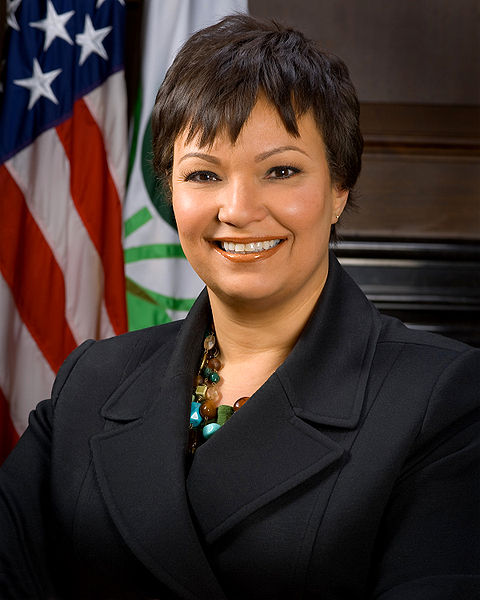 EPA Administrator Lisa JacksonThe Environmental Protection Agency released not one, but two proposals yesterday for regulating the coal ash waste from power plants. The stricter rule of the two would empower the federal government to oversee coal ash like other hazardous waste; the less stringent rule would treat it like ordinary trash and leave oversight up to the states.
EPA Administrator Lisa JacksonThe Environmental Protection Agency released not one, but two proposals yesterday for regulating the coal ash waste from power plants. The stricter rule of the two would empower the federal government to oversee coal ash like other hazardous waste; the less stringent rule would treat it like ordinary trash and leave oversight up to the states.
The agency is asking the public to help it decide which approach makes the most sense during the 90-day comment period.
“We look forward to the comments and participation of the American people,” EPA Administrator Lisa Jackson said during a press conference announcing the proposals.
The EPA began considering federal regulation of coal ash after a catastrophic failure of an impoundment at Tennessee Valley Authority’s Kingston plant in December 2008 sent a billion gallons of waste into a nearby residential community and river. Coal ash is the material left over after coal is burned. It contains toxins including arsenic, chromium, lead, mercury and radioactive elements. It has caused damage including groundwater and surface water contamination at scores of disposal sites nationwide.
Following a months-long review of current coal ash disposal methods in the wake of the Kingston disaster, the agency sent a draft proposed rule to the White House Office of Management and Budget last October. The intention was to release the proposed rule for public comment by year’s end. But the rule got held up at OMB, where it was the target of an intense lobbying campaign by utilities and other interests that do not want the federal government to treat coal ash as hazardous waste.
Both proposals released by EPA would regulate the material under the Resource Conservation and Recovery Act, the primary federal law governing solid waste. But one would regulate coal ash more strictly as a “special waste” under RCRA Subtitle C, which governs hazardous waste, while the other would regulate it less strictly under RCRA Subtitle D, which applies to ordinary household waste.
Under both approaches, EPA would require composite liners and groundwater monitoring at new dry ash landfills, while existing surface impoundments holding wet ash would have to be retrofitted with such liners. Both alternatives would establish dam safety requirements to prevent catastrophic releases like the one at TVA’s Kingston plant. The stricter rule explicitly phases out surface impoundments, but Jackson said she believes the softer alternative would also lead to their phase-out because of the liner retrofitting requirement.
Both rules would continue to allow coal ash to be recycled into concrete and wallboard. However, EPA proposes drawing a distinction between those so-called “beneficial uses” and other uses that essentially constitute disposal operations, such as large-scale structural fills — some of which have been linked to environmental contamination. Neither proposal addresses the use of coal ash for filling mines. The EPA is leaving that up to the Department of Interior’s Office of Surface Mining.
But there are significant differences between the two alternatives — especially in how the rules would be enforced. Regulating coal ash under RCRA Subtitle C would give EPA clear enforcement authority, while placing it under Subtitle D would give EPA the power only to set guidelines for managing coal ash, leaving oversight programs to the states and enforcement to citizen lawsuits.
The agency estimates that the stricter regulations would cost the industry $1.5 billion a year, while the softer ones would cost about $600 million. One reason for the cost difference is that EPA assumes less compliance under the latter approach.
Environmental groups have made clear their preference for the tougher Subtitle C rules.
“For the past 20 years, it has been shown beyond a shadow of a doubt, through rigorous scientific studies conducted by the EPA, the National Academy of Sciences, as well as multiple private and public institutions, that coal combustion waste presents a significant threat to human health and the environment when handled improperly,” said Stephen Smith, director of the Southern Alliance for Clean Energy. “This body of scientific evidence strongly supports the classification of [coal combustion waste] as hazardous waste and the subsequent regulation of this material under Subtitle C of RCRA to ensure responsible storage, transport and disposal.”
Other groups calling for the stricter regulations include Earthjustice, Environmental Integrity Project, Natural Resources Defense Council, Sierra Club and the Southern Environmental Law Center.
The approach that EPA took in releasing two different proposed regulations for public comment is unusual. Rena Steinzor, president of the Center for Progressive Reform, criticized the move, saying the agency will probably have to get another round of public comment before making a final decision.
“The administration could and should have moved ahead months ago with one strong proposal to tackle coal ash,” she said.
EIP Director Eric Schaeffer said EPA’s dual proposal “sets up a boxing ring.” But he sees value in taking the fight that was going on behind OMB’s closed doors out into the open.
“It’s in the public arena now, and that’s really important to move things along,” he said.
The EPA will take comments from the public over the next three months and will also hold public hearings, the details of which have not yet been announced. It has not set a timetable for releasing the final rule.
For a copy of the proposed rule and details on submitting comments, click here.
(This story originally appeared at Facing South.)



